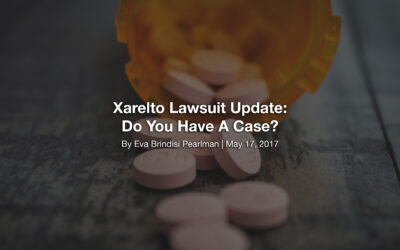Blood thinners are typically used in order to treat blood clots and prevent them from forming. But what causes blood clots? And how do drugs like Xarelto work?
How Blood Clots Form
Medical research tells us blood is a messenger for the body, carrying oxygen, food, hormones, medicine, and more throughout your body. Blood is also a vital line of defense when you suffer from injuries. When you get a cut, your blood clots to prevent germs and other contaminants from entering the wound. And a bruise? That’s essentially a blood clot under your skin. The blood clotted up to prevent internal bleeding from the hit. Therefore, a blood clot is a clump of blood cells that solidifies to block liquid blood from running past.
Your blood clots naturally to seal up wounds. However, if your blood clots elsewhere, it can cause serious health problems. For instance, a blood clot in your veins or arteries can block the blood flow through that vessel which can cause pain and swelling if the clot is located in an extremity. A blood clot that forms at or travels to your heart, lungs, or brain can be fatal.
The Dangers of Blood Clots
Further, medical research tells us clots may form in your heart as a result of an irregular heart rhythm, also known as “atrial fibrillation” or “Afib.” According to the FDA, over 3 million Americans suffer from atrial fibrillation. Patients with Afib, have a much higher risk of stroke as well as blood clots traveling to the brain causing these strokes. You are also at a higher risk for blood clots after major surgery. Surgeries such as hip and knee replacements have an extensive healing period. This means that the veins in your legs may become sluggish, giving it an opportunity to clot. Deep vein thrombosis or DVT is the development of a blood clot in a vein deep beneath the skin. DVT most commonly occurs in the lower leg. If a blood clot blocks blood flow to the lungs, it causes serious damage. This is called a “pulmonary embolism.” Furthermore, people who have often struggled with blood clots in the past are placed on blood-thinning medication to prevent clots in the future.
Blood Thinners
Individuals with these conditions are usually prescribed blood-thinning medication to prevent the blood from clotting. There are two different types of blood-thinning medication: anticoagulants and antiplatelet drugs. Anticoagulants such as warfarin, a drug that has been around since the 1950’s, slows down the clotting process. Antiplatelet medications break up platelets that form the base of a clot, which then prevents the blood clot from forming. Aspirin is an example of an antiplatelet drug.
Side Effects Of Blood Thinners Like Warfarin
Nearly every medication has side effects, and blood thinners are no exception. Typically, the problem with blood-thinning medication is it is too successful. As previously stated, blood clots do have some positive functions, therefore we do not want to completely prevent clotting, just those inside veins, and arteries. But because blood thinners do not differentiate the area of the clot, individuals on blood-thinning medication often are not able to stop bleeding if they are injured or undergoing surgery. Other common side effects include bleeding from the gums, uncontrollable nosebleeds, excessive bleeding from scratches or cuts, and frequent bruising. These side effects are a result of the blood that is not able to clot together, therefore it is difficult to stop bleeding.
Medication reacts differently from person to person, but sometimes blood thinners can turn deadly. Some are so effective that patients are at risk of bleeding to death, which often occurs during a surgery or other medical procedure. Furthermore, injuries causing a bruise or bump could potentially set off internal bleeding that is difficult to stop. If you are on blood thinners and begin to vomit blood or find blood in your urine, you may have an internal bleed and should seek medical attention immediately. Because of these dangerous side effects like serious bleeding, individuals on this medication must have regular check-ups.
Antidotes
Blood thinners that have been in the market for a while like aspirin or warfarin have antidotes that reverse the process if they are too effective. They may also be removed by dialysis. Reversing the process or cleaning your body of the drug stabilizes your condition and the doctor may reevaluate your medication or dosage to create a better balance.
Warfarin vs. Xarelto
Warfarin has been the most popular blood thinner on the market for some time now, and with good reason. Because the dosage varies from person to person, it is difficult to take and also requires users to restrict their diet of foods that are high in vitamin K, like spinach or kale. Patients also have to have monthly exams to confirm the dose is accurate and warfarin is doing its job. Nonetheless, these minimal inconveniences may be worth it as it is both highly effective and has an emergency antidote. If users of warfarin have a dose that is too high, they can be given vitamin K to level it out.
Xarelto and other drugs like Pradaxa and Eliquis have recently been introduced to the market as blood-thinning medication. They are more expensive but appeal to the consumer. If you are on Xarelto instead of warfarin, you don’t have diet restrictions and constant monitoring isn’t needed.
Xarelto’s main ingredient acts on one specific enzyme in the clotting process. The FDA approved the medication for use in patients at risk for DVT and strokes caused by Afib in 2011. In the United States, Janssen Pharmaceuticals, a division of Johnson & Johnson, produces Xarelto. Bayer also produces the drug.
Side Effects of Xarelto
In a case where it’s too good to be true may be accurate, Xarelto has plenty of side effects. The drug can cause serious bleeding that may be uncontrollable. Other blood-thinning medications have an antidote to reverse this process. Xarelto does not. Thus, patients taking Xarelto are at a greater risk of bleeding to death. Various antidotes are in the works but have yet to be approved by the FDA. Some blood thinners may also be removed via dialysis. Xarelto cannot be removed by this process. The FDA states that Xarelto is not affected by dialysis. Serious bleeding may be caused by a major surgery, but could also happen at home with a simple bruise. While on Xarelto, your body cannot form blood clots to prevent the process, so the blood keeps flowing. Once patients begin to experience severe bleeding while taking Xarelto, the consequences may be fatal.
FDA Involvement
The FDA has released numerous warnings about Xarelto and has forced the makers of the medication to change their labeling several times. The FDA has specifically warned users of the risk of uncontrollable bleeding. In fact, the FDA has given Xarelto the black box warning, which is the most serious type of warning on drugs, due to the greater risk of stroke in patients that stop taking Xarelto prematurely as well as the increased risk for swelling and injury-related with the use of epidural anesthesia while on Xarelto.
Makers of Xarelto are unbothered by this. Actually, they have applied to the FDA about expanding the approved uses of Xarelto to treat Acute Coronary Syndrome, a condition that over 1 million patients are hospitalized for each year. With the expansion, Xarelto has serious growth opportunity to add to its already estimated $3 billion sales yearly. The FDA denied this request.
What May Have Went Wrong
One of the clinical trials that lead to Xarelto’s approval for stroke prevention in patients who suffer from Afib is currently under investigation. In this trial, Xarelto was directly compared to warfarin while using a device called INRatio to test warfarin patients. This device was later recalled for inaccurate readings. Consequently, the results of this trial may have been skewed, putting Xarelto on a pedestal when compared to warfarin. The investigation is supposedly reaching a conclusion very soon, but individuals can’t help but wonder if Xarelto was a defective drug before reaching the consumer.
The FDA has repeatedly defended its approval of Xarelto Blood Thinner claiming that its benefits outweigh the side effects and “provides an important health benefit when used as directed. Xarelto also has a short half-life, so it is only in your system for 5-9 hours before your blood returns to normal.
Xarelto Lawsuit
Copious amounts of patients have suffered from the severe side effects of Xarelto. Many have come forward and have issued a lawsuit against its manufacturers Johnson & Johnson and Bayer. The lawsuits claim that the companies knew of the risks of the drug and failed to disclose these risks to medical professionals and patients. By withholding the fact that Xarelto may cause uncontrolled serious bleeding, they put thousands of patients at risk.
Multi-District Litigation
When a large group of people is harmed by the same cause, the individuals may sue together in a class-action lawsuit. When the class sues together, every member shares in the outcome. Class action lawsuits are rare since it is very difficult to form a legally recognized class. Currently, there is no recognized class of Xarelto users. Nonetheless, it does not make sense for thousands of individuals to go at it alone. The victims may not have the resources for a lawsuit. In addition, different courts could reach a different decision in very similar cases, which would be unfair. A possible solution? A Multi-District Litigation, or MDL.
An MDL allows a large number of individual cases to benefit from parts of the class action process without actually needing to become a class. In an MDL, a large number of cases are combined into one proceeding for the pre-trial portions of the case. The pre-trial portions include pre-trial motions, discovery, and settlement sessions. An MDL is used to determine common questions of fact for a great number of cases. Essentially, an MDL concludes what happened. During this process, some cases may settle. Those that do not return to an individual trial, but the facts of the case are pre-determined by the MDL.
With lawsuits ranging from patients suffering severe gastrointestinal bleeding to filing a lawsuit on the behalf of a deceased loved one, thousands of lawsuits against the makers of Xarelto have been filed. Because of this, the U.S. Judicial Panel on Multi-District Litigation has consolidated the class-action lawsuit into an MDL in Louisiana. Moving forward, Honorable Eldon E. Fallon will hear bellwether cases, or test cases to see how the litigation is going to play out. These trials aren’t expected to reach the courtroom until 2017. The outcome of these bellwether trials will have a big effect on all of the outstanding lawsuits pending against these pharmaceutical giants. A verdict for the plaintiffs, in this case, would increase the chances that the defendant companies would opt to settle the remaining cases across the country.
Potential Xarelto Settlement
In settlement meetings, the parties will look at what a jury would award to each individual case. They would also discuss potential strengths and weaknesses if the lawsuit were to go to trial. When negotiating a settlement, the plaintiff should consider the following:
The severity and duration of the injuries from taking Xarelto;
Effects the Xarelto damage has had on the patient’s physical and mental health;
Past and future pain and suffering;
Cost of medical expenses as a result of taking Xarelto;
Amount of lost wages or loss of earning potential;
Loss sustained by family members as a consequence of the patient’s health complications from taking Xarelto.
Questions About Xarelto?
If you or a loved one has suffered from serious bleeding, other health complications, or even wrongful death while taking the Xarelto blood thinner, you may be entitled to compensation. Located in Central New York and searching for Xarelto lawyers in Syracuse NY or lawyers in Utica NY that can help you with your case? Contact Brindisi, Murad, Brindisi & Pearlman today for a free consultation with one of our experienced attorneys. We will evaluate your case thoroughly and explain your legal options moving forward whether it is pursuing compensation or another form of action. As the People’s Lawyers, we will fight for the compensation you deserve.
Share this blog with your friends…
Tags: Xarelto Lawsuit

CONTACT US FOR A FREE CASE EVALUATION
Related Blogs
Invokana: Know The Risks
Invokana, also known as canagliflozin, is an oral diabetes medication that works to control blood sugar levels. Combined with diet and exercise, the drug is prescribed to treat individuals suffering from Type 2 diabetes. While it does help some, it does come...
Xarelto Lawsuit Update: Do You Have A Case?
Millions of Americans suffer from blood clots and strokes every day. In order to prevent these conditions from occurring, physicians often prescribe a blood thinner. A popular type of blood thinner medication is Xarelto. Many choose Xarelto over other blood...
Side Effects Of Lexapro
For millions of Americans, Lexapro provides relief for depression symptoms. In fact, the drug earned $355 million in 2011 alone. Lexapro is medication commonly prescribed to treat those with depression and anxiety disorder. First introduced in its generic form...
Injured In An Accident?
Contact BMBP Today!






BRINDISI, MURAD & BRINDISI PEARLMAN
UTICA OFFICE
Utica, NY 13501
OFFICE HOURS
MONDAY – FRIDAY
9AM-5PM


